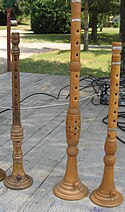Istrian scale
 From Wikipedia - Reading time: 8 min
From Wikipedia - Reading time: 8 min
| Istrian scale | |
|---|---|
Istrian mode on C.[1] [heptatonic] | |
| Stylistic origins | Croatian music |
| Cultural origins | Istria and Kvarner |
| Two-part singing and playing in the Istrian scale | |
|---|---|
| Country | Croatia |
| Reference | 00231 |
| Region | Europe and North America |
| Inscription history | |
| Inscription | 2009 (4th session) |
| List | Representative |


"Istrian scale" refers both to a "unique"[2] musical scale and to the folk music genres from Istria and Kvarner which use that scale.[3] It is named for the Istrian peninsula. Istrian folk music is based on a distinctive six-tone musical scale (the so-called Istrian scale), and the peninsula's two-part, slightly nasal singing. The two-part singing and playing in the Istrian scale, a traditional singing practice characteristic of the Istrian region and the north Adriatic coastal area and islands, was inscribed in UNESCO's List of Intangible Cultural Heritage in 2009.[4]
Genres include kanat and tarankanje; techniques include nasal tone, variation and improvisation, and resolution to the unison or octave; and instruments include double reeds such as sopele, shawms, bagpipes, and other instruments such as flutes and tambura lutes.[3] It was first named by Ivan Matetić Ronjgov early in the twentieth century,[2] assisting his study and notation of Croatian music.
Description
[edit]Non-equal-tempered,[2][5] the scale could approximately be notated as: E-F-G-A♭-B♭-C♭ [hexatonic] (see: enharmonic), the first six notes of an octatonic scale on E. It may be thought of in various ways, such as the Gregorian Phrygian mode with lowered 4th, 5th, and 6th degrees (on E: E-F-G-A♭-B♭-C♭-D [heptatonic]).[6] Performances feature diaphony and the Phrygian cadence (in E: F and D moving to E).[6]

Though, "relative intonation var[ies] considerably from example to example [and between instruments],"[5] the scale has also been described as derived from just intonation: subharmonics seven to fourteen (approximately D, E, F, G♭, A♭, B♭, C, D')( and ).[7]
In Haydn's String Quartet in F minor, Op. 20 No. 5,[2] something like the Istrian mode, but without its top note, is found.[1] Uroš Krek's Inventiones ferales (1962) uses the scale, "in a disguised manner".[8] Tartini may have studied the scale,[2] and Bartók took note of the scale.[7] Karol Pahor's cycle of 15 pieces, Istrijanka (1950), was the result of study of the Istrian mode, as was Danilo Švara's Sinfonia da camera in modo istriano (1957).[9] The Istrian mode occurs in Josip Štolcer-Slavenski's Balkanofonija (1927).[10]
Throughout the areas of Istria and the Kvarner Gulf the distinctive vocal singing has spread, consisting of alternating half and whole steps, which, particularly in older singers' and instrumentalists' renditions, are untempered. The songs are sung by pairs of singers (male, female, or mixed) in a characteristic two-part polyphony in minor thirds (or major sixths) with a cadence to a unison or an octave. Singers distinguish the higher (na tanko "thin") part from the lower (na debelo "fat").[11]
See also
[edit]References
[edit]- ^ a b c Van der Merwe, Peter (2005). Roots of the Classical, p.227-8. ISBN 978-0-19-816647-4.
- ^ a b c d e Thammy Evans, Rudolf Abraham (2013). Istria: Croatian Peninsula, Rijeka, Slovenian Adriatic, p.17. ISBN 9781841624457.
- ^ a b "Two-part singing and playing in the Istrian scale", UNESCO.org.
- ^ Antos, Zvjezdana; Fromm, Annette B.; and Golding, Viv (2017). Museums and Innovations, p.78. Cambridge Scholars. ISBN 9781443862561. Cites: [1].
- ^ a b Marušić, Dario. "Reception of Istrian Musical Traditions", Musicology 7/2007 (VII) ("Reception of Istrian Musical Traditions", doiSerbia).
- ^ a b Žganec, Vinko; Sremec, Nada, eds. (1951). Hrvatske narodne pjesme i plesovi. Vol. 1. Zagreb: Seljačka sloga. p. 228.
- ^ a b Ruland, Heiner (1992). Expanding Tonal Awareness, p.43. Rudolf Steiner. ISBN 9781855841703. Described by Kathleen Schlesinger on the Greek aulos
- ^ (2001). Muzikološki zbornik: Musicological annual, Volumes 37–39, p.86. [full citation needed]
- ^ Ray Robinson, Regina Chĺopicka, eds. (2003). Studies in Penderecki: Penderecki and the avant garde, p.137. ISBN 9780911009118.
- ^ Samson, Jim (2013). Music in the Balkans, p.381. Brill. ISBN 9789004250383.
- ^ Rice, Timothy; Porter, James; and Goertzen, Chris (2017). The Garland Encyclopedia of World Music: Europe, unpaginated. Routledge. ISBN 9781351544269.
Further reading
[edit]- Bezić, Jerko. "Yugoslavia, Folk Music: Croatia", New Grove Dictionary 2:594.
External links
[edit]- "Two-part singing and playing in the Istrian scale" (UNESCO), YouTube.com.
- "Few words about traditional Istrian Music and Dance", Istria from Smrikve.
- "The folk music of Krk Island", Gold and Silver Dots.
 KSF
KSF